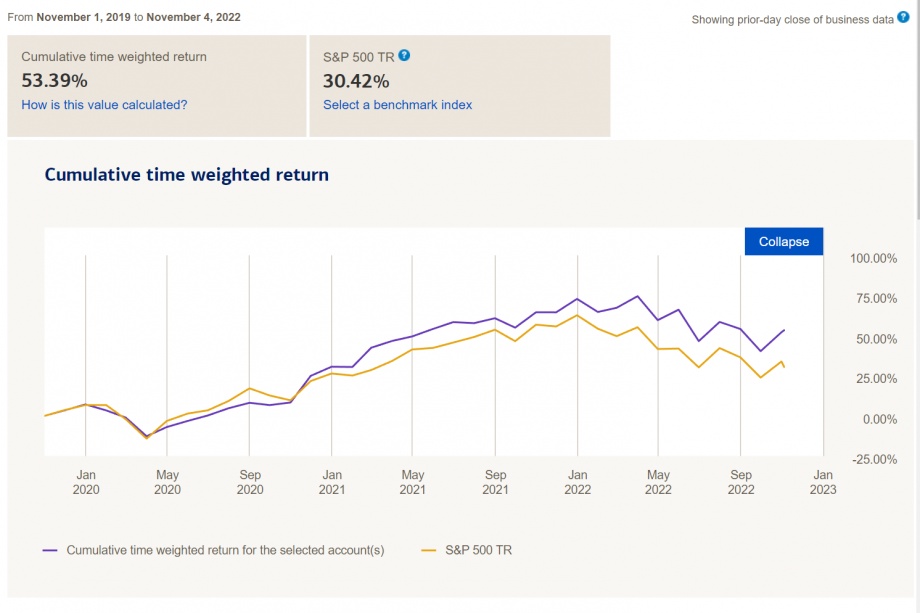CyclingInvestor
Thinks s/he gets paid by the post
3.3% at the moment on 100% individual equities
So it's interesting that the dividend yield % number can look 'better' (higher), even if it is lower in absolute terms, if the market value of the assets dropped further than the dividends.No idea; likely higher than last year - especially given the reduced valuations.
what anyone learns from a single number like this.-ERD50
...
12/11/2021-12/11/2022 vs. 12/11/2020-12/11/2021:
Portfolio change: 0.935x
Total income change: 1.58x
Total dividend change: 1.45x
Total interest change: 2.11x
The increase in interest income is not surprising, of course. The dividend increase is more interesting. It is due to my picking up more energy stocks and other value stocks, and they pay more dividends than the overall S&P. ...
In short, I have gained more income in both $ amounts as well as in yields. The drop of portfolio value in dollar amount is a heck of a lot more than the income, but that's the way stock values fluctuate.
...
This is one of the reasons I love dividends. They tend to weather fluctuations better than the stock prices.
Apples/oranges. The OP asked about portfolio yield as his/her measure of SWR from the portfolio. Your example is the yield of a hypothetical individual stock that varied (cut?) its dividend by 1/3 and had its stock price cut in half.So it's interesting that the dividend yield % number can look 'better' (higher), even if it is lower in absolute terms, if the market value of the assets dropped further than the dividends.
Hypothetical Example - A $3 dividend on $100 worth of stock is 3% yield.
A year later, the dividend has dropped to $2, but the stock has dropped to $50, so the dividend yield is now 'better' at 4%. But certainly not 'better' for someone 'living off dividends'!
I'm not sure what anyone learns from a single number like this.
-ERD50
Quicken makes it easy for me to pull up the number.
Last 12-month dividend+interest over current portfolio value: 2.69%.
Whoa, it's the same as the OP's number. What coincidence!
I used the trailing 12-month number, because I don't yet have the year-end value for 2022, but my number includes the year-end value of 2021...
For me, another source of income is the option premium I get from writing covered calls on the stocks I hold, and covered puts on the cash.
Again, it's easy to use Quicken to look at the sum of these option premiums over the trailing 12 months. I will just say that it's significantly more than the 2.69% above. Altogether, it helps me keep up with inflation (not quite, but it helps).
In dollar amount, I would say that my time spent writing options pays more than 2x per hour what I made when last working, and I was quite reasonably compensated as a contracted engineer.
This income is not adjusted downward for the opportunity cost less taxes of the gains you missed out on when you have stocks called away from you, right?
I'm guessing it's probably hard to say how much as I think you buy and sell stocks as well as write options.
(Signed, a passive Bogle-type who is curious but lazy)

Apples/oranges. The OP asked about portfolio yield as his/her measure of SWR from the portfolio. Your example is the yield of a hypothetical individual stock that varied (cut?) its dividend by 1/3 and had its stock price cut in half.Originally Posted by ERD50 View Post
So it's interesting that the dividend yield % number can look 'better' (higher), even if it is lower in absolute terms, if the market value of the assets dropped further than the dividends.
Hypothetical Example - A $3 dividend on $100 worth of stock is 3% yield.
A year later, the dividend has dropped to $2, but the stock has dropped to $50, so the dividend yield is now 'better' at 4%. But certainly not 'better' for someone 'living off dividends'!
I'm not sure what anyone learns from a single number like this.
-ERD50
No, I think it applies.
OP mentioned the % yield, and yes, he has decided that this is his WR (safe or not is always questionable).
So that % could be higher than last year, but the amount could be lower (even across the whole portfolio). So I still don't see the point. You don't pay bills in % of your portfolio, you pay in dollar amounts.
-ERD50
If you bought an asset decades ago, is it meaningful to look at its original cost as the basis for the yield?
So I still don't see the point. You don't pay bills in % of your portfolio, you pay in dollar amounts.-ERD50
my best dividend performer is Broadcom that is currently paying over 15% yield on cost.
Why not? It sure can indicate a great performing stock that grows its dividend.
ETA: I bought AVGO between 2013 and 2015, so it hasn’t been decades.
The problem is that over a long period, the early performance may mask out the recent performance of the asset.
The earlier growth phase may be exceptional, but if the asset's recent performance is trailing the market one may investigate the cause. Perhaps it is time to sell it and replace with something else.
PS. I cross-posted with Samsung, who had the same idea.
Title of thread.Why would focus on only one metric.
Yield on cost gives a more accurate representation of the value of a dividend investment. I may calculate to total yield on cost tomorrow. I do know my best dividend performer is Broadcom that is currently paying over 15% yield on cost.
